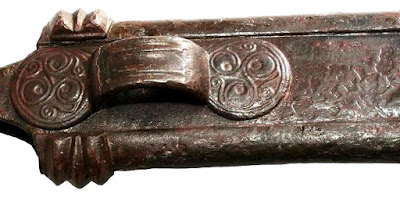 |
| A copy of a design from 7th century Ireland carved by the author |
Let's get precise!
For antiquarians of the late 1800’s and early 1900’s the symbol was often figured to be a relation to the swastika (minus a limb) and therefore associated with the sun.
Geometrically concise, the basic construction method of a triskele originates with a hexagram - from which many images of the Celtic Iron Age take shape. The hexagon is composed of two equilateral triangles, representing the equilibrium between male and female elements (in many cultures there exists a mythic triad e.g; the Trimurti of Hinduism, in which the cosmic functions of creation, maintenance and destruction are personified by Brahma, Vishnu and Shiva*).
Triskeles also said to embody the golden ratio, one of the core principles of Pythagorean mystic thought, with which the Celtic druids became acquainted with via Abaris, a follower of Pythagoras. However the triple spirals of the infamous Newgrange tumulus predate these Iron Age conceptions (see the previous post).
The triskele can also represent the unification of the three Celtic kingdoms air, earth and water. Many Celtic coins have the solar symbol punched in their centre, binding them to the sun god perhaps… Often the legs of the triskele become the bodies or necks of animals, most notably birds.
The triskele also featured on a lot of Celtic military equipment across Europe and the Balkans - suggesting the symbol offered some form of magical protection.
The Triskele and the Triple Goddess
Triple goddesses are attested in Celtic literature as well as archaeologically. Triadic goddesses (Matres or Matronae) appear as refinements, or reflections, of deities. This concept of the many from one reaches far back into the depths of time. The Matronae were widely worshipped across ancient Europe. At least 1100 shrines still exist, indicating a complex of goddess worship spread across old Europe.
It's often been assumed that the trickle is the symbol of the 'triple goddess. The one thing that strikes me is there's no Matronae imagery portrayed alongside the triskele - which strikes me as a little odd. However, there exist Grecian spells and hymns that mention a triple Goddess; Hecate, Persophone and Selene, and these spells are accompanied by powerful 'triskele' evoking imagery
- triple pointed
- triple-headed
- triple voiced
- triple-pointed
- triple faced
- triple necked
The triskele also shows up in a lot of Celtic-Christian and Catholic sculpture and art. Just as the Christian church appropriated the symbol for their own religious needs, so too earlier forms of paganism utilised the triskele, warping its nature to suit their template. Perhaps in this endeavour the symbol has evolved, adopted fresh layers with each wave of migrants.
It's a rich tangle, and there's no easy answer. Perhaps, as with any symbol, it boils down to what feels right to you, how the symbol sits in your sights. To a large degree we superimpose our own templates of perception upon such devices. This template is formed by our nature, the way we are nurtured, by environment and the influence that forms the intricate mesh of our experience.
Sources used in this post:
1: Cross And Spiral - The Triskele In Early Christian Art - Brendan Mac Gonagle
4: https://en.wikipedia.org/wiki/Shamrock
5: Symbol And Image In Celtic Religious Art - Miranda Green
5: Symbol And Image In Celtic Religious Art - Miranda Green
Check out this website to see methods of spiral and triskele construction using triangles and hexagons - HERE
* note the similarity here between the modern version of the triskele reflecting the earth goddess and the idea of life, death rebirth… maintenance, destruction, creation.
* note the similarity here between the modern version of the triskele reflecting the earth goddess and the idea of life, death rebirth… maintenance, destruction, creation.
**three-faced god images appear in Gaul right up to Scotland. I wonder if such deities had the ability to gaze into the different worlds or from the present into the future and the past.
*** the earliest reference to this appears on coins from the 1600’s.




No comments:
Post a Comment